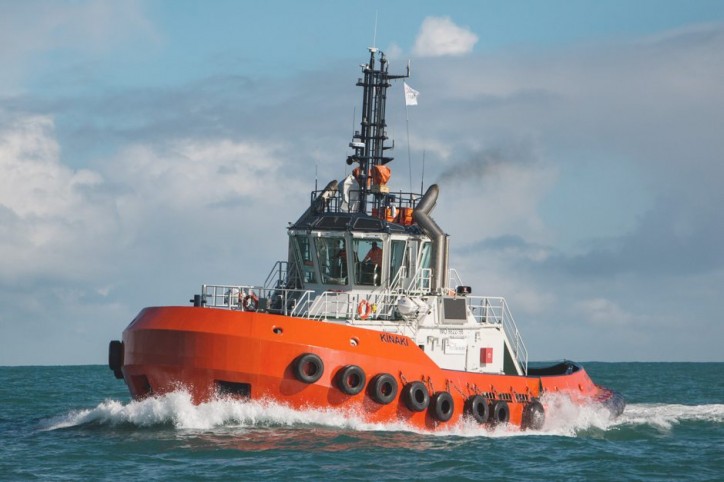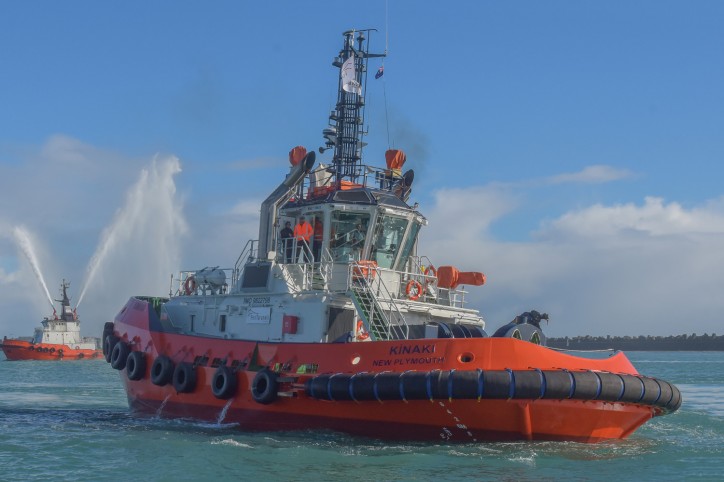In June 2018 the new 25 metre harbour tractor tug Kinaki completed its 73-day journey via heavy lift transport ship from Istanbul, Turkey, and arrived safely in Lyttelton, New Zealand. From there it sailed on its own bottom to its new home with Port Taranaki in New Plymouth.

This latest addition to the Port Taranaki tug fleet was built at Istanbul’s Sanmar Shipyards and was the first to be completed in their TRAktor 2500-SXseries. Measuring at less than 24 metres loadline length, Kinaki packs in a lot of power and can sustain a bollard pull of 62 tonnes. The tug will be operated by 3 crew and is meant to replace the oldest of Port Taranaki’s three tugs, the 47-year-old Kupe.
Having met several members of the Port Taranaki organization during sea trials for Kinaki, it is really a pleasure to see one of our designs reside with a company where community involvement is of utmost importance. The name Kinaki was chosen by Ngati Te Whiti hapu and Port Taranaki through discussions with hapu (Maori sub-tribe) representatives including kaumatua (respected elders). Kinaki is also the name of one of two mouri (life principal) stones situated within the breakwater of Port Taranaki. A blessing ceremony will be performed prior to the tug formally entering into service at the port.

Kinaki’s hull and appendage arrangement was extensively model tested at the Vienna Model Basin and also analysed in house at Robert Allan Ltd. using computational fluid dynamics (CFD). The end result is an optimal balance between controllability, manoeuvrability, fuel efficiency and roll dampening. The stern of the hull features the simple but extremely effective StRAke stabilizers developed by Robert Allan Ltd. and Voith, for improved tractor tug directional stability allowing for a reduced skeg size and thereby improving manoeuvrability and fuel efficiency. These features were of particular importance to Port Taranaki’s operation in the tough conditions experienced on New Zealand’s west coast.
Particulars of Kinaki are:
- Length Overall: 25.3 m
- Length (Loadline): < 24 m
- Beam, moulded, extreme: 12.0 m
- Depth, moulded (hull): 4.55 m
- Maximum draft: 5.74 m
- Gross Tonnage: 336 GT
The tug was designed and constructed to satisfy all applicable Rules and Regulations of ABS Class. Tank capacities are as follows:
- Fuel Oil: 84 m3
- Potable Water: 12 m3
- Main Engine Lube Oil: 0.6 m3
- Fi-Fi Foam: 3.9 m3
- Used Oil Tank: 3.0 m3
- Sewage Tank: 6.7 m3
Trials results were as follows:
- Bollard Pull, ahead: 62 tonnes
- Free running speed, ahead: > 12.5 knots
The vessel has been outfitted to the highest standards for a normal operating crew of three, with accommodations for up to six persons. One double cabin is located on the main deck, with two additional double crew cabins located on the lower accommodation deck. There is also a galley, mess room, and wet gear room located on the main deck.
The deck machinery comprises a DMT type TW-021-E250kN double drum towing winch on the aft deck, spooled with 165 metres of Ø60 mm hawser towline on each drum.
The raised forecastle and elevated wheelhouse ensure good all-round visibility of the working decks and especially when performing ship-assist operations off the stern (the main working end of the tug). The higher bow freeboard feature provides an enhanced standard of sea-keeping when working in exposed waters and helps keep green water from getting onboard to a minimum.
Main propulsion comprises a pair of CAT 3512C diesel engines, each rated 1902 bkW at 1800 rpm, and each driving a Rolls-Royce US 205 CP P20 Z-drive unit, with a 2.5 m diameter controllable pitch propeller.
The electrical plant consists of two (2) identical CAT C4.4 diesel gen-sets, each with a power output of 99 ekW at 1500 rpm.
Ship-handling fenders at the stern consist of one tier of 800 mm OD x 400 mm ID cylindrical fender at the main deck level. Tires provide protection at the main and forecastle sides and sheer lines, and a single row of 300 mm hollow “D” fender protects the bilge.
Source: Robert Allan Ltd